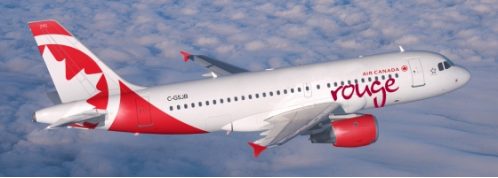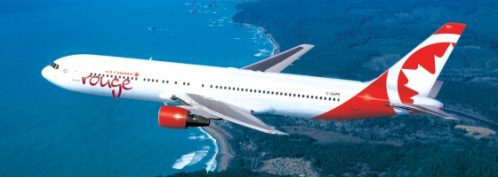Air Canada has unveiled the launch plans of its new leisure airline, marking a major step in the transformation of Canada’s flag carrier to compete in the growing leisure travel sector. The carrier, named Air Canada rouge, will inaugurate services from July 1, 2013 using a mixed fleet of Airbus A319s and Boeing 767-300ERs being retired from the mainline business. Its network will initially cover Athens, Edinburgh and Venice in Europe and destinations in Cuba, Dominican Republic, Jamaica and Costa Rica across the Americas.
“With the introduction today of Air Canada rouge, Air Canada enters today’s growing leisure travel market on a truly competitive basis,” said Ben Smith, executive vice president and chief commercial officer, Ben Smith. “In partnership with Air Canada Vacations, part of our new leisure group, Air Canada rouge will leverage the strengths of Air Canada’s extensive network, operational expertise and frequent flyer reward program in order to offer Canadians great value for their vacation travel.”
The launch of Air Canada rouge will allow the Canadian flag carrier to compete more aggressively in the highly competitive leisure travel market with lower-cost competitors like Transat AT, Sunwing and WestJet Vacations. Interestingly, two of its initial long-haul routes are new to the Air Canada network, while Athens is already served on a seasonal basis by the business. Senior executives at the carrier had suggested previously that the lower-cost structure of the new leisure business would allow it to compete effectively on routes it would not have been able to serve with the mainline model.
Air Canada rouge’s fleet will initially comprise of four aircraft – two Airbus A319s and two Boeing 767-300ERs. The Airbus models will be used within the Americas and will be configured in an all-economy configuration for 142 passengers offering a selection of rouge Plus seats with additional legroom. The 767-300ERs will be used on Transatlantic services and will be arranged in a two-cabin configuration for 264 passengers offering a selection of rouge Plus seats with additional legroom and Premium rouge seats featuring additional seating comfort, space and enhanced meal and beverage service.
The two 767-300ERs are being released from the mainline fleet in 2013 following the arrival of two 777-300ERs and additional aircraft will be added to the Air Canada rouge fleet as the national carrier starts to take delivery of its new 787 Dreamliners in 2014. Subject to commercial demand, Air Canada rouge is expected to operate up to 20 767-300ERs and 30 Airbus A319s to pursue opportunities in markets made viable by Air Canada rouge’s lower operating cost structure.

“With leisure time at a premium, Air Canada rouge will combine affordable fares, great service and choice leisure destinations with those benefits offered by Air Canada and Air Canada Vacations that are valued most by vacation travelers,” said Michael Friisdahl, president and chief executive officer, Air Canada’s Leisure Group. The name Air Canada rouge was selected following a contest launched on Facebook inviting customers, employees and travel industry professionals for their input.
As mentioned above, Air Canada rouge will initially serve three long-haul destinations – Athens in Greece, Edinburgh in Scotland and Venice in Italy. The mainline business has served the Greek capital from Toronto and Montreal on a seasonal basis since summer 2010 so has a good understanding of the passenger demographic already. The start-up will offer two weekly flights between Montreal and Athens and four weekly services between Toronto and Athens, competing with leisure rival Air Transat on the latter route.
Air Canada rouge will also compete with Air Transat between Toronto and Venice, a brand new market for Canada’s flag carrier. It plans to introduce a three times weekly link from July 3, 2013 and will complement its business schedules to Rome Fiumicino from Montreal and Toronto. An estimated 46,000 O&D passengers flew between Toronto and Venice in 2011 with around 22.2 per cent of this total flying on Air Canada’s existing network to Europe and connecting via partner carriers.
The Scottish capital, Edinburgh, will be another new market for Air Canada and its three times weekly link from July 2, 2013 will represent the first regular scheduled flights into the Scottish capital from Canada since summer 2009 when Air Transat previously served the route – during the 2000s flyglobepsan, Skyservice Airlines and Thomas Cook Airlines had also linked Edinburgh to either Hamilton or Toronto. Although Edinburgh is not currently served from Canada, Glasgow, less than an hour away was a former Air Canada network point from the early 1990s through to 2004. It is now linked to Toronto by Air Transat and Sunwing Airlines and to Calgary and Vancouver by Air Transat.
An estimated 12,000 O&D passengers flew between Toronto and Edinburgh in 2011, while around 83,000 O&D passengers took advantage of the direct services of Air Transat between Toronto and Glasgow the same year. This shows the strong market potential for the new service which alongside stimulating the market will almost certainly attract a number of passengers currently travelling across to Glasgow from Central and Southern Scotland, as well as parts of Northern England.
“I've always believed that Scotland and Canada should be better served with air links and it’s fitting that Air Canada's new airline should launch its first services from Edinburgh,” said Gordon Dewar, chief executive officer, Edinburgh Airport. “Our airlines tell us that they prosper at Scotland’s busiest airport and I’m confident that Air Canada Rouge will be no different.” Interestingly, VisitScotland, claims that 30 per cent of Canadians prefer to use Air Canada to access Scotland so this is significant opportunity for growth.

In the Americas region, Air Canada rouge will take over the current mainline flights that Air Canada operates for Air Canada Vacations to ten destinations across the Caribbean from Toronto. The airline will operate five flights per week to the Dominican Republic with three weekly services to Punta Cana and weekly rotations to Puerto Plata and Samana; three weekly flights to Costa Rica with a twice weekly link to San Jose and weekly flight to Liberia; a five times weekly offering to Kingston, Jamaica and six weekly flights to Cuba – a three times weekly Varadero link and weekly rotations to Cayo Coco, Holguin and Santa Clara.
The formal details on the new low-cost venture have been released just weeks after Air Canada outlined its own network expansion plans for summer 2013, including growth in international markets. The carrier is launching a new non-stop route between Toronto and Seoul, starting service to Istanbul subject to government approval, adding seven weekly departures to Beijing from Toronto and Vancouver, and upgrading its Calgary-Tokyo Narita route to provide daily service.
"Air Canada is seizing the opportunities of the Pacific Century with the most far-reaching international expansion of its schedule in its 75-year history. Our new routes embrace the world from Istanbul to Seoul and deepen our already extensive Asian service,” said Ben Smith, executive vice president and chief commercial officer, Air Canada. “With our Asia expansion alone, we will be flying eleven daily departures or more than 43,000 seats a week across the Pacific Ocean this summer - a commitment of up to 14 widebody aircraft valued in excess of $2 billion.”
The introduction of a three times weekly link between Toronto and Seoul Incheon from June 2, 2013 will add a fifth Asian destination to Air Canada’s network map from Toronto. The year-round service, operated with a Boeing 777-300ER, will complement the carrier’s existing route between Vancouver and the South Korean capital.
In 2011 an estimated 383,000 O&D passengers travelled between Canada and South Korea, with Air Canada holding a 35.5 per cent share of this traffic. The market is currently dominated by South Korean flag carrier and SkyTeam alliance member Korean Air which holds a 45.8 per cent share of the O&D demand with existing non-stop links to both Toronto and Vancouver.
Alongside the new Seoul link, Air Canada will also boost its presence in existing markets in Asia. An additional three weekly departures between Toronto and Beijing will be added from June 1, 2013, increasing flights to ten a week, while four more flights will be added on the Vancouver – Beijing route to boost weekly frequencies to eleven. The revised schedule will also introduce a new late night flight designed for business travelers. Elsewhere, Air Canada will upgrade its Calgary – Tokyo Narita service to a daily schedule from May 1, 2013, up from five a week last summer.
The other new network point planned for Air Canada’s mainline business is Istanbul. Subject to Government approval, the carrier plans to introduce a three times weekly link from Istanbul from June 4, 2013 using a Boeing 767-300ER. The flight will be operated with a Boeing 767-300ER and will be the only early evening departure to Istanbul from the Canadian city.
“Our service to Istanbul, the bridge between Europe and Asia, adds an exciting destination to the Air Canada network with easy connections throughout Turkey and points in Central Asia, the Middle East and Africa with our Star Alliance partner Turkish Airlines," explained Ben Smith.
Turkish Airlines introduced its own non-stop flights between Istanbul and Toronto in July 2009, while leisure carrier Air Transat has been operating a weekly link to the Turkish city from Montreal since May 2011. In 2011 an estimated 135,000 O&D passengers travelled between Canada and Turkey, with approximately 53,000 flying between Toronto and Istanbul. Air Canada already holds around a 9.2 per cent share of this market through its existing flights to Europe and onward connections from the likes of Frankfurt and Munich through its Star Alliance partners.
